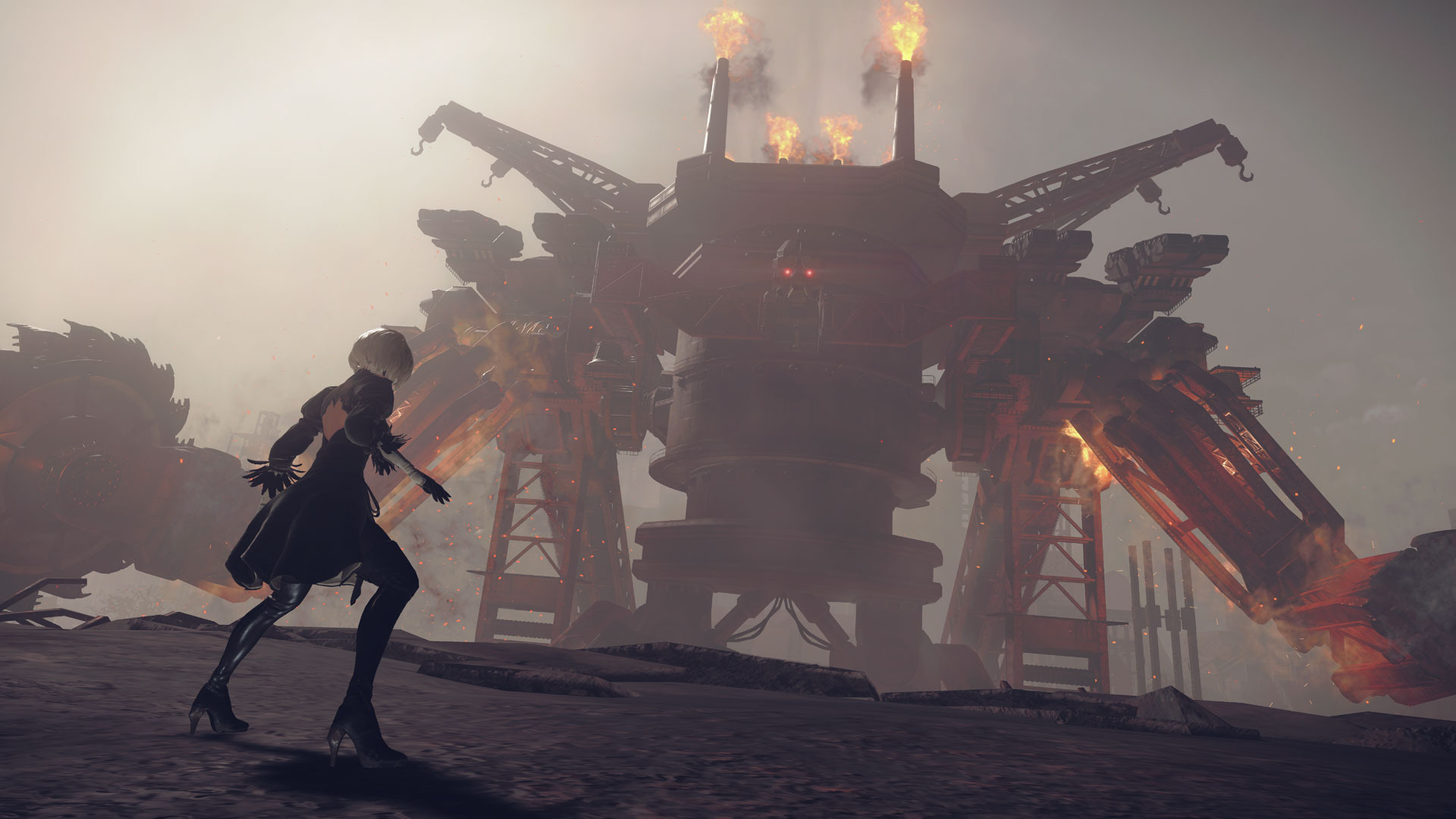Nier: Automata is a good game after one trip through its world. It’s a great game after three. Creator Yoko Taro takes the player’s familiarity with science fiction conceits and uses them to lure him or her into a sense of complacency, then continually builds and complicates his themes and his world until it’s hard to know which way is up anymore. The result is mesmerizing and completely unlike any game released this year.
The setting is the far-future. Humanity has abandoned the planet Earth entirely, leaving behind a race of androids created in their image. These creations are at constant war with the “machines,” another race of sentient robots sent by an alien race to invade Earth. As android unit 2B, your role is to fight back the machine menace so that humanity can have its planet back.
As one might expect, the idea of a never-ending proxy war has some parallels to our real world. The game doesn’t shy away from cliches surrounding artificial intelligence, either. Nier: Automata is far from the first piece of art or entertainment to question what defines humanity, and whether that could potentially apply to artificial beings. But there are a few twists to these tropes that add some dimensions to the game.
For one, there are no humans in the game, bypassing the question of whether true artificial intelligence deserves to be treated as human entirely. The androids at the center of the narrative constantly call this into question by suggesting that the machines are incapable of rationality and emotions, but because even the androids are one step removed from humanity, their criticisms are intentionally absurd. There’s never any doubt that the machines’ varied desires are legitimate, because we’ve already accepted through the protagonists that, in this world, AI can have a soul.
Because the game doesn’t directly challenge the player’s notions of humanity the way that many similar stories do, the first playthrough can feel a bit like it’s going through the narrative motions at times. There’s no doubt that the machine village will serve as your friends. Of course 2B and her companion 9S will forge an emotional bond. To be honest, after the first time I finished the game, I was a tad underwhelmed by its neat and tidy ending. But leaving Nier: Automata after “finishing” the story (which many reviews seem to have done) would be doing it a great disservice.
To say that Nier: Automata opens up in its “New Game Plus” mode would be a massive understatement. It is immediately apparent after restarting the game that, while your experience will cover a lot of the same sequences that you saw the first time, things are very different. Without spoiling too much, you get an outside perspective of the events of the game, a lot of background on tertiary characters, a number of completely new set-pieces with brand new game elements, and a massive twist which, while somewhat predictable (I guessed it only a few hours into my first playthrough), significantly reshapes the game’s narrative.
It all pales in comparison to the next time you restart, though. Again, I don’t want to delve too deeply into what exactly this third “route” consists of, but Nier: Automata has one of the most audacious final chapters I’ve ever played. Not since Metal Gear Solid 2 have I seen a game so completely dismantle much of what came before, as the story twists in on itself again and again until the player is just as lost as the characters. It quickly subverts the hope and positivity of the initial ending with a series of tragedies and reveals that leave the characters devastated. It delves deeply into existentialism and the importance of purpose, hits rock bottom, and somehow brings the player back out of despair through a shockingly effective meta-game. It’s incredible.
Nier: Automata is a game that leans heavily into its story, but it doesn’t shirk its responsibilities to be entertaining, either. Developer Platinum Games borrows liberally from one of its other franchises, the critically-lauded Bayonetta, to deliver a deeply satisfying and accessible combat system. Players can equip weapons to act as their light and heavy attacks, similar to Bayonetta’s hand/feet system, and the right shoulder button is devoted to evading, which, if done at the right moment, slows down time and allows for a counter attack.
That’s not to say that it’s as complex or as challenging as the Bayonetta series. I admittedly found myself wishing for that game’s depth at times, but in all honesty, it’s not necessary here. The combat plays as support for the story, not the other way around. Nier: Automata also borrows quite a lot from the “bullet hell” genre, with semi-regular top-down shooter segments, and enemies that shoot orbs at players to do damage. You’re outfitted with an ever-present “pod” that allows you to shoot back at enemies’ ranged attacks, meaning even hand-to-hand fights can shift into a 3D bullet hell scenario if certain enemies are present.
It’s a bit frustrating to sing Nier: Automata’s praises, because to truly appreciate the game for what it is, you have to play it. Many of its most powerful moments are best left unspoiled, waiting to be discovered. It’ll take you 30-40 hours to uncover all of its secrets, but even in a year with an overwhelming number of instant classics, you owe it to yourself to check out this brilliant, completely original work.

I find Yoko Taro and Platinum Games a perfect match. The game looks gorgeous and it is pretty engaging. Good review. And thanks for not spoiling it 😉
Thanks!